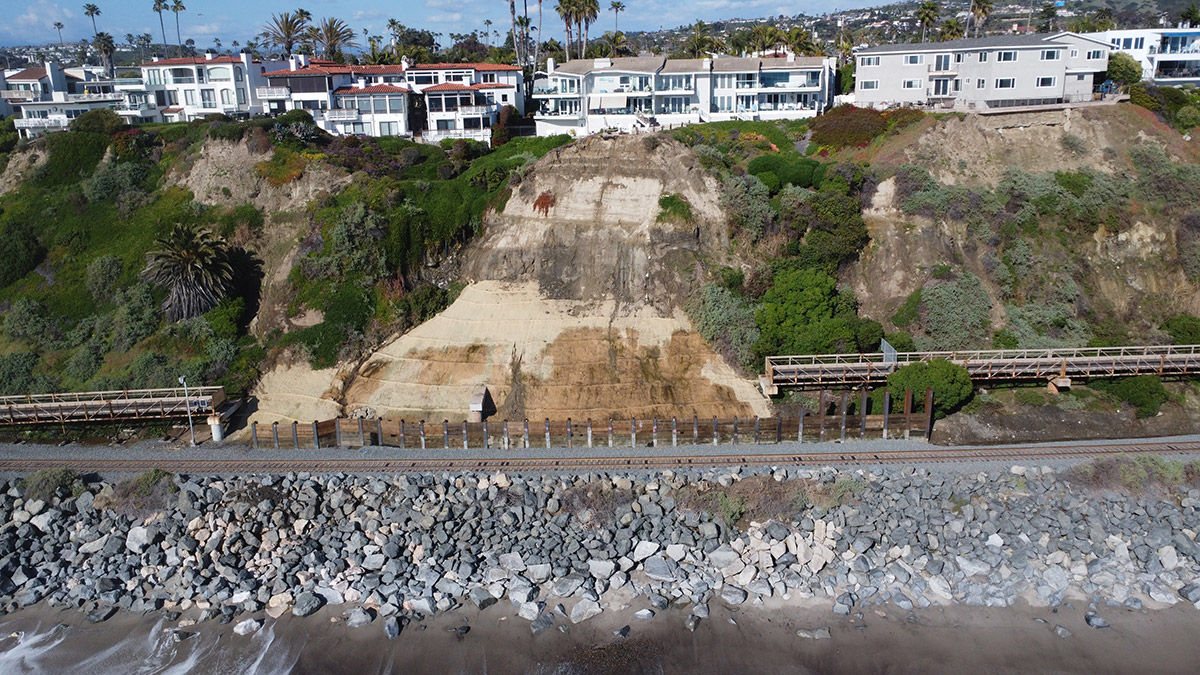Following multiple listening sessions, OCTA Board feedback, and other stakeholder input, OCTA unveils updated plans that include sand nourishment, rock revetment, and a wall to protect the most vulnerable section of rail line through San Clemente
ORANGE – OCTA has updated its potential solutions to address immediate threats to rail service through San Clemente, and sand nourishment – always under consideration – is a key piece in the coastal rail protection puzzle.
The updated potential solutions are detailed in a report to be presented to the agency’s Regional Transportation Planning Committee on Monday, May 6, and to the full Board of Directors on Monday, May 13. The updates come following multiple listening sessions, OCTA Board feedback, and other stakeholder input on OCTA’s Coastal Rail Resiliency Study – an effort to protect a critical link in Southern California’s rail infrastructure.
“As we’ve said throughout the study process, sand is part of the solution as eroding beaches continue to pose a threat to rail operations,” said OCTA CEO Darrell E. Johnson. “In response to the feedback to date, we refined our initial concepts and included sand, along with riprap, a wall, and engineered revetment in the most vulnerable areas to give us a clearer picture of what solutions could look like.”
OCTA’s CEO had an opportunity to discuss this effort earlier this week in Sacramento at a hearing of the State Senate Transportation Subcommittee on LOSSAN Rail Corridor Resiliency. The subcommittee, chaired by Sen. Catherine Blakespear (D-Encinitas), also included testimony from local, regional and state officials. (Click here to view the hearing.)
In his comments, Johnson underscored the importance of involving multiple stakeholders – from the community, from regulatory agencies, and others in developing and determining a successful path forward.
OCTA’s Coastal Rail Resiliency Study aims to evaluate and implement short- and medium-term strategies to protect the railway in the vulnerable 7-mile stretch between Dana Point and the San Diego County Line and to keep rail traffic moving through the area for up to the next 30 years, while longer-term solutions are explored.
The updated initial assessment to be presented Monday identifies areas along that stretch in need of reinforcement and monitoring, to prevent additional soil and debris from privately owned hillsides falling into the rail right-of-way. The potential solutions for the immediate threat areas are meant to protect the track from threats on the coastal and inland side caused by erosion and storm surges, among other risks.
The updated potential solutions for immediate reinforcement include but are not limited to providing sand nourishment in conjunction with building additional catchment walls and engineering placement of large protective boulders (known as riprap), where appropriate.
The immediate goal is to address the areas identified in need of reinforcement as soon as possible before the next storm season arrives. OCTA will continue to work with local, state and federal partners and explore all funding options. Rough estimates on the updated potential solutions range from approximately $210 million to $340 million depending on multiple factors including the permitting process, and availability of materials, and specialized equipment, including sourcing and delivery methods for sand nourishment. In conjunction with the other potential solutions, approximately 500,000 cubic yards of sand have been identified as needed, enough to cover 285 football fields in one foot of sand.
At the same time as the initial assessment is moving forward, OCTA continues working on the Coastal Rail Resiliency Study, meeting with groups of stakeholders in individual listening sessions to discuss the study and get input along the way. A public meeting to gain additional feedback is set from 5 to 6:30 p.m. on May 30, at San Clemente City Hall.
These concepts, developed with community input, are scheduled to be presented later this year, then refined, before a draft plan to address protecting the rail line in place for the next 10 to 30 years goes to the OCTA Board in 2025.
Because California continues to grapple with the increasing prevalence of storm-related damage to its transportation infrastructure, OCTA recognizes the importance of adaptive strategies to maintain safe and efficient rail services.
OCTA will also work with all partners and stakeholders to explore long-term solutions for protecting rail movement for generations to come – solutions that could eventually include moving the rail line inland. As part of those long-term efforts, OCTA is advocating for state-led capital project effort to address concerns along the 351-mile LOSSAN corridor to safeguard the future of rail transportation across the region.
